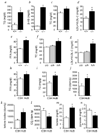Positional cloning of the combined hyperlipidemia gene Hyplip1
- PMID: 11753387
- PMCID: PMC2846781
- DOI: 10.1038/ng811
Positional cloning of the combined hyperlipidemia gene Hyplip1
Abstract
Familial combined hyperlipidemia (FCHL, MIM-144250) is a common, multifactorial and heterogeneous dyslipidemia predisposing to premature coronary artery disease and characterized by elevated plasma triglycerides, cholesterol, or both. We identified a mutant mouse strain, HcB-19/Dem (HcB-19), that shares features with FCHL, including hypertriglyceridemia, hypercholesterolemia, elevated plasma apolipoprotein B and increased secretion of triglyceride-rich lipoproteins. The hyperlipidemia results from spontaneous mutation at a locus, Hyplip1, on distal mouse chromosome 3 in a region syntenic with a 1q21-q23 FCHL locus identified in Finnish, German, Chinese and US families. We fine-mapped Hyplip1 to roughly 160 kb, constructed a BAC contig and sequenced overlapping BACs to identify 13 candidate genes. We found substantially decreased mRNA expression for thioredoxin interacting protein (Txnip). Sequencing of the critical region revealed a Txnip nonsense mutation in HcB-19 that is absent in its normolipidemic parental strains. Txnip encodes a cytoplasmic protein that binds and inhibits thioredoxin, a major regulator of cellular redox state. The mutant mice have decreased CO2 production but increased ketone body synthesis, suggesting that altered redox status down-regulates the citric-acid cycle, sparing fatty acids for triglyceride and ketone body production. These results reveal a new pathway of potential clinical significance that contributes to plasma lipid metabolism.
Figures





Similar articles
-
Fine mapping of Hyplip1 and the human homolog, a potential locus for FCHL.Mamm Genome. 2001 Mar;12(3):238-45. doi: 10.1007/s003350010265. Mamm Genome. 2001. PMID: 11252174
-
Mapping a gene for combined hyperlipidaemia in a mutant mouse strain.Nat Genet. 1998 Apr;18(4):374-7. doi: 10.1038/ng0498-374. Nat Genet. 1998. PMID: 9537422
-
Familial combined hyperlipidemia is associated with upstream transcription factor 1 (USF1).Nat Genet. 2004 Apr;36(4):371-6. doi: 10.1038/ng1320. Epub 2004 Feb 29. Nat Genet. 2004. PMID: 14991056
-
Familial combined hyperlipidemia: An overview of the underlying molecular mechanisms and therapeutic strategies.IUBMB Life. 2019 Sep;71(9):1221-1229. doi: 10.1002/iub.2073. Epub 2019 Jul 4. IUBMB Life. 2019. PMID: 31271707 Review.
-
[Familial combined hyperlipidemia].Nihon Rinsho. 1999 Dec;57(12):2776-81. Nihon Rinsho. 1999. PMID: 10638212 Review. Japanese.
Cited by
-
Role of iron in carcinogenesis: cancer as a ferrotoxic disease.Cancer Sci. 2009 Jan;100(1):9-16. doi: 10.1111/j.1349-7006.2008.01001.x. Epub 2008 Oct 23. Cancer Sci. 2009. PMID: 19018762 Free PMC article. Review.
-
Minireview: Thioredoxin-interacting protein: regulation and function in the pancreatic β-cell.Mol Endocrinol. 2014 Aug;28(8):1211-20. doi: 10.1210/me.2014-1095. Epub 2014 Jun 9. Mol Endocrinol. 2014. PMID: 24911120 Free PMC article. Review.
-
The α-Arrestin ARRDC3 Is an Emerging Multifunctional Adaptor Protein in Cancer.Antioxid Redox Signal. 2022 May;36(13-15):1066-1079. doi: 10.1089/ars.2021.0193. Epub 2022 Jan 4. Antioxid Redox Signal. 2022. PMID: 34465145 Free PMC article. Review.
-
Deficiency of thioredoxin binding protein-2 (TBP-2) enhances TGF-β signaling and promotes epithelial to mesenchymal transition.PLoS One. 2012;7(6):e39900. doi: 10.1371/journal.pone.0039900. Epub 2012 Jun 29. PLoS One. 2012. PMID: 22768160 Free PMC article.
-
Mitochondrial apolipoprotein A-I binding protein alleviates atherosclerosis by regulating mitophagy and macrophage polarization.Cell Commun Signal. 2022 May 7;20(1):60. doi: 10.1186/s12964-022-00858-8. Cell Commun Signal. 2022. PMID: 35525979 Free PMC article.
References
-
- Genest JJ, Jr, et al. Familial lipoprotein disorders in patients with premature coronary artery disease. Circulation. 1992;85:2025–2033. - PubMed
-
- Grundy SM, Chait A, Brunzell JD. Familial combined hyperlipidemia workshop. Arteriosclerosis. 1987;7:203–207.
-
- Nikkila EA, Aro A. Family study of serum lipids and lipoproteins in coronary heart-disease. Lancet. 1973;1:954–959. - PubMed
-
- Castellani LW, et al. Mapping a gene for combined hyperlipidaemia in a mutant mouse strain. Nature Genet. 1998;18:374–377. - PubMed
Publication types
MeSH terms
Substances
Associated data
- Actions
Grants and funding
LinkOut - more resources
Full Text Sources
Other Literature Sources
Molecular Biology Databases

